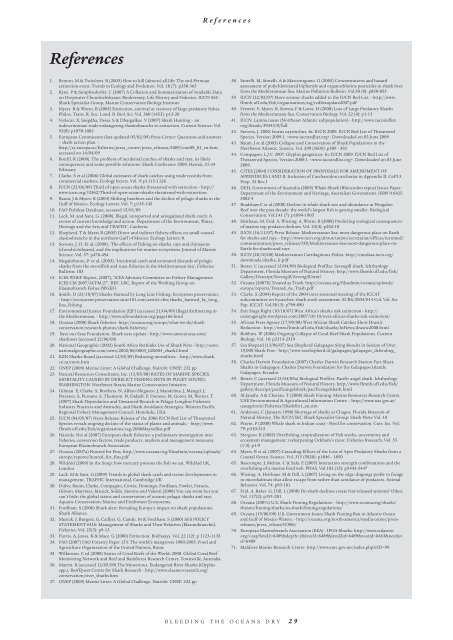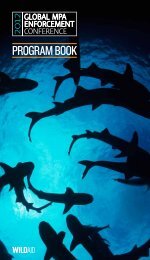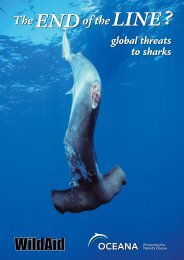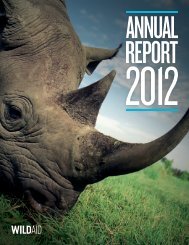Bleeding the Oceans Dry - WildAid
Bleeding the Oceans Dry - WildAid
Bleeding the Oceans Dry - WildAid
- No tags were found...
You also want an ePaper? Increase the reach of your titles
YUMPU automatically turns print PDFs into web optimized ePapers that Google loves.
R e f e r e n c e sReferences1. Benton. M & Twitchett. R (2003) How to kill (almost) all life: The end-Permianextinction event. Trends in Ecology and Evolution. Vol. 18 (7): p358-3652. Kyne. P & Simpfendorfer. C (2007) A Collation and Summarization of Available Dataon Deepwater Chondrichthyans: Biodiversity, Life History and Fisheries. IUCN SSCShark Specialist Group, Marine Conservation Biology Institute3. Myers. R & Worm. B (2005) Extinction, survival or recovery of large predatory fishes.Philos. Trans. R. Soc. Lond. B. Biol. Sci. Vol. 360 (1453): p13-204. Verlecar. X, Snigdha, Desai. S & Dhargalkar. V (2007) Shark Hunting – anindescriminate trade endangering elasmobranchs to extinction. Current Science. Vol.92(8): p1078-10825. European Commission (last updated 05/02/09) Press Corner: Questions and answers– shark action plan. –http://ec.europa.eu/fisheries/press_corner/press_releases/2009/com09_01_en.htm,accessed on 14/04/096. Bonfil. R (2000). The problem of incidental catches of sharks and rays, its likelyconsequences and some possible solutions. Shark Conference 2000, Hawaii, 21-24February7. Clarke. S et al (2006) Global estimates of shark catches using trade records fromcommercial markets. Ecology letters. Vol. 9: p1115-11268. IUCN (25/06/09) Third of open ocean sharks threatened with extinction - http://www.iucn.org/?3362/Third-of-open-ocean-sharks-threatened-with-extinction9. Baum, J & Myers. R (2004) Shifting baselines and <strong>the</strong> decline of pelagic sharks in <strong>the</strong>Gulf of Mexico. Ecology Letters. Vol. 7: p135-14510. FAO FishStat Database, accessed 15/01/0911. Lack, M. and Sant, G. (2008). Illegal, unreported and unregulated shark catch: Areview of current knowledge and action. Department of <strong>the</strong> Environment, Water,Heritage and <strong>the</strong> Arts and TRAFFIC, Canberra12. Shepherd. T & Myers R (2005) Direct and indirect fishery effects on small coastalelasmobranchs in <strong>the</strong> nor<strong>the</strong>rn Gulf of Mexico. Ecology Letters: 8.13. Stevens, J. D. Et al, (2000), ‘The effects of fishing on sharks, rays and chimaeras(chondrichthyans), and <strong>the</strong> implications for marine ecosystems. Journal of MarineScience. Vol. 57: p476-49414. Megalofonou, P. et al, (2003), ‘Incidental catch and estimated discards of pelagicsharks from <strong>the</strong> swordfish and tuna fisheries in <strong>the</strong> Mediterranean Sea’, FisheriesBulletin: 10315. ICES WGEF Report, (2007), ‘ICES Advisory Committee on Fishery Management:ICES CM 2007/ACFM:27’, REF. LRC, Report of <strong>the</strong> Working Group onElasmobranch Fishes (WGEF)16. Smith. D (25/10/07) Sharks Harmed by Long Line Fishing. Ecosystem preservation.- http://ecosystem-preservation.suite101.com/article.cfm/sharks_harmed_by_long_line_fishing17. Environmental Justice Foundation (EJF) (accessed 21/04/09) Illegal driftnetting in<strong>the</strong> Mediterranean. - http://www.ejfoundation.org/page166.html18. Oceana (2008) Shark fisheries- http://oceana.org/europe/what-we-do/sharkconservation/research-photos/shark-fisheries/19. Save our Seas Foundation. Shark nets update - http://www.saveourseas.com/sharknets (accessed 22/06/09)20. National Geographic (2002) South Africa Rethinks Use of Shark Nets - http://news.nationalgeographic.com/news/2002/06/0603_020604_shark2.html21. KZN Sharks Board (accessed 12/05/09) Reducing mortalities. - http://www.shark.co.za/mort.htm22. UNEP (2009) Marine Litter: A Global Challenge. Nairobi: UNEP. 232 pp23. Natural Resources Consultants, Inc. (15/05/08) RATES OF MARINE SPECIESMORTALITY CAUSED BY DERELICT FISHING NETS IN PUGET SOUND,WASHINGTON. Northwest Straits Marine Conservation Initiative.24. Gilman. E, Clarke. S, Bro<strong>the</strong>rs. N, Alfaro-Shigueto. J, Mandelma. J, Mangel. J,Petersen. S, Piovano. S, Thomson. N, Dalzell. P, Donoso. M, Goren. M, Werner. T(2007) Shark Depredation and Unwanted Bycatch in Pelagic Longline Fisheries:Industry Practices and Attitudes, and Shark Avoidance Strategies. Western PacificRegional Fishery Management Council, Honolulu, USA.25. IUCN (04/05/07) News Release: Release of <strong>the</strong> 2006 IUCN Red List of ThreatenedSpecies reveals ongoing decline of <strong>the</strong> status of plants and animals. - http://www.flmnh.ufl.edu/fish/organizations/ssg/2006Mayredlist.pdf26. Hareide. Net al (2007) European shark fisheries: a preliminary investigation intofisheries, conversion factors, trade products, markets and management measures.European Elasmobranch Association27. Oceana (2007a) Hunted for Fins. http://www.oceana.org/fileadmin/oceana/uploads/europe/reports/hunted_for_fins.pdf28. <strong>WildAid</strong> (2009) In <strong>the</strong> Soup: how mercury poisons <strong>the</strong> fish we eat. <strong>WildAid</strong> UK,London29. Lack. M & Sant. G (2009) Trends in global shark catch and recent developments inmanagement. TRAFFIC International, Cambridge UK30. Dulvy, Baum, Clarke, Compagno, Cortés, Domingo, Fordham, Fowler, Francis,Gibson, Martínez, Musick, Soldo, Stevens and Valenti (2008) You can swim but youcan’t hide: <strong>the</strong> global status and conservation of oceanic pelagic sharks and rays.Aquatic Conservation: Marine and Freshwater Ecosystems.31. Fordham. S (2006) Shark alert: Revealing Europe’s impact on shark populations.Shark Alliance.32. Musick. J, Burgess. G, Cailliet. G, Camhi. M & Fordham. S (2000) AFS POLICYSTATEMENT #31b: Management of Sharks and Their Relatives (Elasmobranchii).Fisheries. Vol. 25(3): p9-1333. Purvis. A, Jones. K & Mace. G (2000) Extinction. BioEssays. Vol. 22 (12): p 1123-113334. FAO (2007) FAO Forestry Paper 153: The world’s mangroves 1980-2005. Food andAgriculture Organization of <strong>the</strong> United Nations, Rome35. Wilkinson. C ed (2008) Status of Coral Reefs of <strong>the</strong> World: 2008. Global Coral ReefMonitoring Network and Reef and Rainforest Research Center, Townsville, Australia.36. Martin. R (accessed 12/05/09) The Mysterious, Endangered River Sharks (Glyphisspp.). ReefQuest Centre for Shark Research - http://www.elasmo-research.org/conservation/river_sharks.htm37. UNEP (2009) Marine Litter: A Global Challenge. Nairobi: UNEP. 232 pp38. Storelli. M, Storelli. A & Marcotrigiano. G (2005) Concentrations and hazardassessment of polychlorinated biphenyls and organochlorine pesticides in shark liverfrom <strong>the</strong> Mediterranean Sea. Marine Pollution Bulletin. Vol.50 (8): p850-85539. IUCN (22/02/07) More oceanic sharks added to <strong>the</strong> IUCN Red List. - http://www.flmnh.ufl.edu/fish/organizations/ssg/redlistupdate2007.pdf40. Ferretti. F, Myers. R, Serena. F & Lotze. H (2008) Loss of Large Predatory Sharksfrom <strong>the</strong> Mediterranean Sea. Conservation Biology. Vol. 22 (4): p1-1341. IUCN. Lamna nasus (Nor<strong>the</strong>ast Atlantic subpopulation) - http://www.iucnredlist.org/details/39343/0/full42. Stevens, J. 2000. Isurus oxyrinchus. In: IUCN 2009. IUCN Red List of ThreatenedSpecies. Version 2009.1. . Downloaded on 03 June 200943. Baum. J et al (2003) Collapse and Conservation of Shark Populations in <strong>the</strong>Northwest Atlantic. Science. Vol. 299 (5605): p389 - 39244. Compagno, L.J.V. 2007. Glyphis gangeticus. In: IUCN 2009. IUCN Red List ofThreatened Species. Version 2009.1. . Downloaded on 03 June2009.45. CITES [2004] CONSIDERATION OF PROPOSALS FOR AMENDMENT OFAPPENDICES I AND II: Inclusion of Carcharodon carcharias in Appendix II. CoP13Prop. 32 Rev.146. DEH, Government of Australia (2005) Whale Shark (Rhincodon typus) Issues Paper.Department of <strong>the</strong> Environment and Heritage, Australian Government. ISBN 0 64255082 447. Bradshaw.C et al (2008) Decline in whale shark size and abundance at NingalooReef over <strong>the</strong> past decade: <strong>the</strong> world’s largest fish is getting smaller. BiologicalConservation. Vol.141 (7): p1894-190548. Heithaus. M, Frid. A, Wirsing. A, Worm. B (2008) Predicting ecological consequencesof marine top predator declines. Vol. 23(4): p202-1049. IUCN (16/11/07) Press Release. Mediterranean Sea: most dangerous place on Earthfor sharks and rays. - http://www.iucn.org/about/union/secretariat/offices/iucnmed/communication/press_releases/?58/Mediterranean-Sea-most-dangerous-place-on-Earth-for-sharks-and-rays50. IUCN (28/10/08) Mediterranean Cartilaginous Fishes. http://cmsdata.iucn.org/downloads/sharks_lr.pdf51. Bester. C (accessed 15/04/09) Biological Profiles: Sevengill shark. IchthyologyDepartment, Florida Museum of Natural History. http://www.flmnh.ufl.edu/fish/Gallery/Descript/Sevengill/Sevengill.html52. Oceana (2007b) Treated as Trash. http://oceana.org/fileadmin/oceana/uploads/europe/reports/Treated_As_Trash.pdf53. Clarke. S (2004) Report of <strong>the</strong> 2004 inter-sessional meeting of <strong>the</strong> ICCATsubcommittee on bycatches: shark stock assessment. SCRS/2004/014 Col. Vol. Sci.Pap. ICCAT. Vol.58 (3): p799-89054. Exit Stage Right (10/10/07) West Africa’s sharks risk extinction - http://exitstageright.wordpress.com/2007/10/10/west-africas-sharks-risk-extinction/55. African Press Agency (17/09/08) West African Shark Catches Show DrasticReduction - http://www.flmnh.ufl.edu/fish/sharks/InNews/drastic2008.html56. Robbins. W (2006) Ongoing Collapse of Coral-Reef Shark Populations. CurrentBiology. Vol. 16: p2314-231957. Sea Shepard (13/06/07) Sea Shepherd Galapagos Sting Results in Seizure of Over19,000 Shark Fins - http://www.seashepherd.nl/galapagos/galapagos_defending_sharks.html58. Charles Darwin Foundation (2007) Charles Darwin Research Station Fact Sheet:Sharks in Galapagos. Charles Darwin Foundation for <strong>the</strong> Galapagos Islands.Galapagos, Ecuador59. Bester. C (accessed 15/04/09a) Biological Profiles: Pacific angel shark. IchthyologyDepartment, Florida Museum of Natural History. http://www.flmnh.ufl.edu/fish/gallery/descript/pacificangelshark/pacificangelshark.html60. Al-Janahi. A & Cherian. T (2008) Shark Finning. Marine Resources Research Centre,UAE Environmental & Agricultural Information Centre. - http://www.uae.gov.ae/uaeagricent/Fisheries/Sharkfin1_en.stm61. Anderson. C (January 1998) Shortage of sharks at Chagos. Florida Museum ofNatural History. The IUCN/SSC Shark Specialist Group: Shark News Vol. 1062. Pravin. P (2000) Whale shark in Indian coast - Need for conservation. Curr. Sci. Vol.79: p310-31563. Stergiou. K (2002) Overfishing, tropicalization of fish stocks, uncertainty andecosystem management: resharpening Ockham’s razor. Fisheries Research. Vol. 55(1-3): p1-964. Myers. R et al, (2007) Cascading Effects of <strong>the</strong> Loss of Apex Predatory Sharks from aCoastal Ocean. Science. Vol. 315 (5820): p1846 - 185065. Bascompte. J, Melián. C & Sala. E (2005) Interaction strength combinations and <strong>the</strong>overfishing of a marine food web. PNAS. Vol.102 (15): p5443-544766. Wirsing. A, Heithaus. M & Dill. L (2007) Living on <strong>the</strong> edge: dugongs prefer to foragein microhabitats that allow escape from ra<strong>the</strong>r than avoidance of predators. AnimalBehavior. Vol. 74: p93-10167. Frid. A, Baker. G, Dill. L (2008) Do shark declines create fear-released systems? Oikos.Vol. 117(2): p191-20168. Oceana (2007c) U.S. Shark Finning Regulations. - http://www.oceana.org/sharks/threats/finning-sharks/us-shark-finning-regulations/69. Oceana (19/06/09) U.S. Government Issues Shark Finning Ban in Atlantic Oceanand Gulf of Mexico Waters. - http://oceana.org/north-america/media-center/pressreleases/press_release/0/806/70. European Elasmobranch Association (EEA) - IPOA-Sharks. http://www.eulasmo.org/v.asp?level2=6489&depth=2&level3=6489&level2id=6489&rootid=6463&nextlevel=648971. Maldives Marine Research Centre- http://www.mrc.gov.mv/index.php?cID=99b l e e d i n g t h e o c e a n s d r y 2 9





